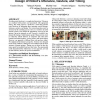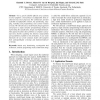659 search results - page 78 / 132 » Using formal models to design user interfaces: a case study |
DSS
2007
13 years 8 months ago
2007
The primary objective of a knowledge-based system (KBS) is to use stored knowledge to provide support for decision-making activities. Empirical studies identify improvements in de...
INFOCOM
2010
IEEE
13 years 7 months ago
2010
IEEE
Abstract—We consider a cognitive radio network where multiple secondary users (SUs) contend for spectrum usage, using random access, over available primary user (PU) channels. Ou...
HRI
2009
ACM
14 years 3 months ago
2009
ACM
Providing route directions is a complicated interaction. Utterances are combined with gestures and pronounced with appropriate timing. This study proposes a model for a robot that...
CHI
2006
ACM
14 years 9 months ago
2006
ACM
Our current understanding of human interaction with hybrid or augmented environments is very limited. Here we focus on `tangible interaction', denoting systems that rely on e...
ERSA
2009
13 years 6 months ago
2009
For a generic flexible efficient array antenna receiver platform a hierarchical reconfigurable tiled architecture has been proposed. The architecture provides a flexible reconfigur...


